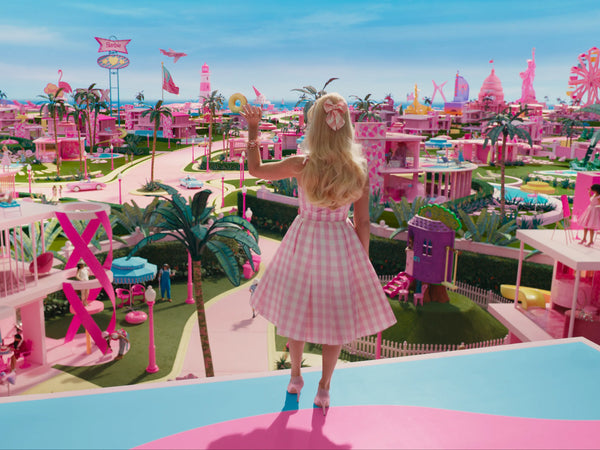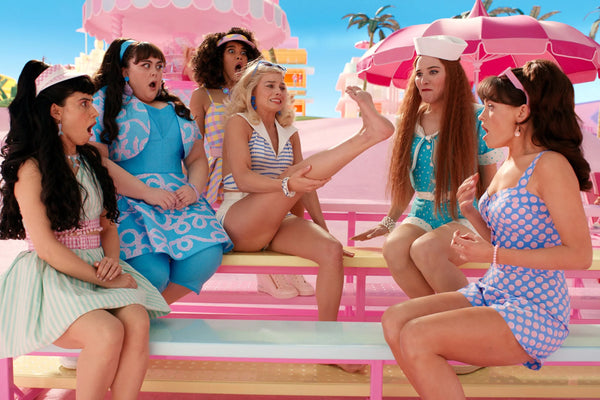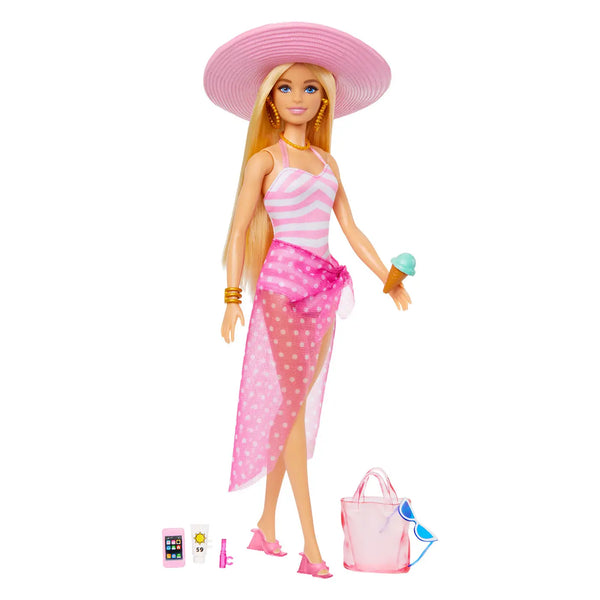
Barbie the Movie New Toys and Playsets
Barbie: From the Toy Shelf to the Silver Screen
In the realm of pop culture, certain icons stand the test of time, transcending their original form to become ingrained in the fabric of society. One such icon is Barbie, the iconic fashion doll that has been a beloved companion for generations of children. However, Barbie's influence extends far beyond the toy shelf; she has made a seamless transition from plastic to pixels, becoming a cultural phenomenon that now graces the silver screen. This article delves into the fascinating journey of "Barbie the Movie," exploring the evolution of Barbie from a simple doll to a cinematic sensation.

The Genesis of Barbie
Before Barbie dazzled audiences on the big screen, she was the brainchild of Ruth Handler, the co-founder of Mattel Inc. In 1959, Barbie made her debut at the American International Toy Fair in New York City, instantly capturing the hearts and imaginations of young girls. Ruth Handler envisioned Barbie as more than just a doll; she saw her as a vehicle for young minds to explore various careers and possibilities. From fashionista to astronaut, Barbie was designed to be a reflection of a girl's dreams.
Over the decades, Barbie underwent numerous transformations, adapting to changing cultural norms and societal expectations. She became a symbol of empowerment and diversity, embracing a variety of professions, ethnicities, and body types. Barbie's ability to evolve with the times laid the foundation for her enduring popularity and set the stage for her leap into the world of cinema.
Barbie's Evolution in Entertainment
As technology advanced and entertainment mediums diversified, Barbie seamlessly made her mark in various forms of media. From animated television series to direct-to-video movies, Barbie's foray into entertainment paved the way for her eventual transition to the silver screen.
One of the earliest instances of Barbie in animation was the "Barbie and the Rockers" television special in the 1980s. This marked the beginning of Barbie's animated adventures, captivating young audiences and solidifying her status as more than just a doll. The success of these animated endeavors laid the groundwork for a new frontier—Barbie's venture into feature films.

Lights, Camera, Barbie!
The decision to bring Barbie to the big screen was not made lightly. Mattel, recognizing Barbie's global appeal and cultural significance, sought to create a cinematic experience that would resonate with audiences of all ages. In 2001, the first Barbie movie, "Barbie in the Nutcracker," was released, marking a milestone in Barbie's entertainment journey.
The Nutcracker adaptation set the stage for a string of successful Barbie movies, each exploring different genres and themes. From fairy tales like "Barbie as Rapunzel" to adventurous tales like "Barbie: Princess Charm School," each film brought a unique flavor to the Barbie universe. As the franchise expanded, so did Barbie's cinematic universe, introducing new characters, settings, and storylines that kept audiences coming back for more.
One of the standout successes was "Barbie as The Princess and the Pauper" (2004), a musical extravaganza that showcased Barbie's versatility. The film not only entertained with its catchy tunes but also conveyed valuable lessons about identity, friendship, and self-discovery. This marked a turning point for Barbie movies, proving that they could be both entertaining and socially relevant.
The Barbie Brand: A Cinematic Powerhouse
As the Barbie movie franchise gained momentum, it became clear that Barbie was not just a toy but a cinematic powerhouse. The movies became an integral part of the Barbie brand, contributing to its ever-growing popularity. The success of these films was not solely attributed to the nostalgic appeal of the doll but also to the creative storytelling, vibrant animation, and positive messages they conveyed.
One key aspect of Barbie movies' success was the attention to detail in animation and design. The movies embraced cutting-edge animation techniques, creating a visually stunning experience for audiences. The intricate detailing of Barbie's world, from her elaborate wardrobe to the enchanting settings, transported viewers into a realm of fantasy and imagination.
Furthermore, the storytelling in Barbie movies evolved to encompass a wide range of genres and themes. From historical adventures like "Barbie as The Princess and the Pauper" to modern tales like "Barbie: Princess Charm School," the movies offered something for everyone. This versatility contributed to the enduring appeal of Barbie, attracting audiences of different ages and tastes.
Barbie's Impact on Popular Culture
As Barbie movies continued to make waves at the box office, their impact on popular culture became increasingly evident. Barbie was no longer confined to the realms of toy stores and playrooms; she had become a cultural icon with a significant influence on fashion, entertainment, and societal perceptions.
The fashion showcased in Barbie movies became a source of inspiration for designers and fashion enthusiasts alike. Barbie's ever-changing wardrobe, filled with glamorous gowns and stylish ensembles, set trends and influenced the way people perceived fashion. The movies not only entertained but also served as a visual feast for fashion enthusiasts, showcasing the latest trends in miniature form.
Beyond fashion, Barbie movies played a crucial role in breaking down stereotypes and promoting inclusivity. The diverse cast of characters in Barbie movies challenged traditional norms and celebrated differences. From showcasing various ethnicities to portraying characters with different abilities, Barbie movies became a platform for promoting diversity and acceptance.
Barbie in the 21st Century: A Digital Transformation
As the 21st century unfolded, Barbie underwent another transformation, adapting to the digital age. The rise of streaming platforms and digital content consumption paved the way for a new era of Barbie movies. No longer confined to traditional theaters, Barbie's cinematic adventures found a new home in the digital landscape.
The shift to digital platforms allowed Barbie movies to reach a global audience instantly. Viewers could enjoy the latest Barbie adventure with just a click, further solidifying Barbie's status as a global phenomenon. The accessibility of Barbie movies on streaming platforms ensured that new generations could experience the magic of Barbie, continuing the legacy for years to come.
The digital era also brought interactive experiences to Barbie fans. Online games, apps, and virtual worlds allowed children to engage with Barbie in unprecedented ways. The integration of technology into the Barbie brand not only kept it relevant but also enhanced the overall experience for fans.
New Barbie the Movie Dolls and Playsets
What has also got fans excited is the chance to see some new Barbie dolls and playsets inspired by the movie. Mattel has been teasing fans with previews of the dolls, and they look phenomenal. The new dolls feature an updated look for Barbie, with sleeker and more modern clothes, hairstyles and accessories. But the toy makers have not forgotten the classic Barbie look. They have stuck to her iconic colour scheme of pink and white, giving fans the best of both worlds. But that's not all - the sets that come with the dolls offer a glimpse into the movie's plot, making the whole experience even more exciting.
One particular Barbie set that has got fans abuzz is the "Barbie Dreamtopia Brush 'n Sparkle Unicorn". The set comes with a unicorn that lights up and plays music, along with a Barbie doll and accessories. However, it is not just a simple toy - the unicorn's horn doubles as a "magic" brush that the doll can use to comb her hair. The unicorn also has over 15 different sound and light combinations, making it a toy that will keep kids entertained for hours.Another set that is sure to be popular is the "Barbie Glam Convertible Car". The car is a replica of the one in the movie, and comes with a sleek design and pink interior. The car also has working headlights and a sound system that plays realistic car sounds, making it the perfect toy for young Barbie fans.
But the real star of the new Barbie dolls is the diverse range of characters that are being introduced. The new dolls feature different body types, skin tones, and hair textures - a reflection of Mattel's commitment to promoting diversity and inclusivity. From a curvy "Barbie Fashionista" doll to a "Barbie Astronaut" with a buzz cut, the new dolls break free from stereotypes and offer something for everyone.
The Legacy Continues: Barbie's Enduring Appeal
As we reflect on the journey of "Barbie the Movie," it becomes evident that Barbie's transition from toy to cinematic icon is a testament to her enduring appeal. Barbie has not only stood the test of time but has evolved and thrived in the ever-changing landscape of popular culture.
The success of Barbie movies goes beyond mere entertainment; it reflects the universal themes of imagination, empowerment, and friendship that resonate with audiences of all ages. Barbie's ability to adapt to changing times, embrace diversity, and stay true to her core values has solidified her place in the hearts of millions around the world.
As we eagerly await the next chapter in Barbie's cinematic journey, one thing is certain: Barbie will continue to inspire, entertain, and captivate audiences, proving that she is not just a doll but a cultural icon whose influence extends far beyond the toy shelf. Whether in plastic or pixels, Barbie remains a timeless symbol of dreams, possibilities, and the enduring power of storytelling.
![]()
